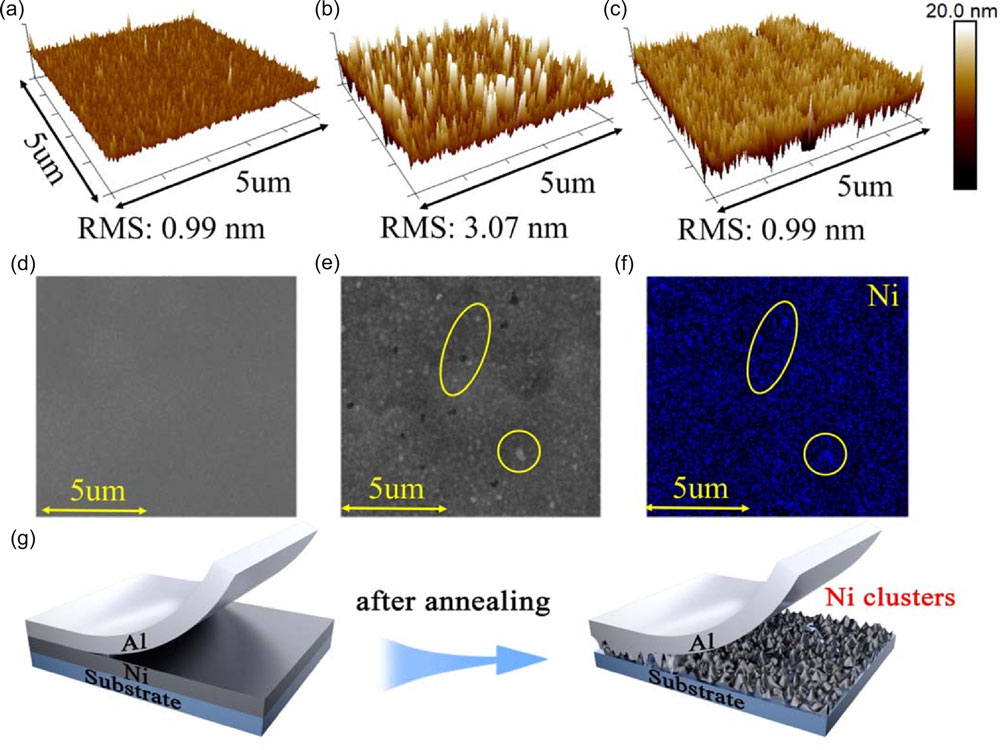News: LEDs
29 July 2021
Annealed Ni/Al DUV LED p-electrodes
Researchers based in China have improved the performance of 277nm-wavelength deep-ultraviolet (DUV) light-emitting diodes (LEDs) by using reflective nickel/aluminium (Ni/Al) electrodes in place of conventional nickel/gold (Ni/Au) [Xianchun Peng et al, Appl. Phys. Express, vol14, p072005, 2021].
DUV LEDs with emission wavelengths shorter than 280nm are being sought as compact, environment-friendly alternatives to mercury lamps for water/surface disinfection and bio-agent detection. Presently, this development is hampered by low energy efficiency and power output.
A number of effects contribute to the low efficiency compared with longer-wavelength LEDs based on III-nitride semiconductors such as aluminium gallium nitride (AlGaN). The best 275nm LED so far achieved 20% external quantum efficiency (EQE). In that case more than half of the power was lost due to low light-extraction efficiency.
Reflective p-electrodes enable more light to be extracted from the sapphire side of the device. The flip-chip configuration with sapphire-side up is generally favored since sapphire is UV transparent, while the apparently unavoidable p-GaN contact layers heavily absorb wavelengths shorter than the ~3.4eV bandgap, which corresponds to wavelengths ~365nm.
The research team - from Ningbo University, Ningbo Institute of Materials Technology and Engineering, University of Chinese Academy of Sciences, Zhe Jiang Bright Semiconductor Technology Co Ltd, and Advanced Micro-Fabrication Equipment Inc - deposited the Ni/Al electrodes by electron-beam evaporation, followed by rapid thermal annealing (RTA). The Ni and Al thicknesses were 5nm and 300nm, respectively.
The Ni/Al was applied to AlGaN and DUV materials grown on sapphire by metal-organic chemical vapor deposition (MOCVD). The LEDs were fabricated with titanium/aluminum/nickel gold (Ti/Al/Ni/Au) contacts to the n-type layer exposed by mesa reactive-ion etching.
The Ni/Al (or conventional unannealed Ni/Au) p-type electrodes were then deposited after annealing at 800°C for 1 minute. The p-contact layers of the DUV structure consisted of 100nm p-AlGaN and 10nm p+-GaN. The heavy doping of the final layer improved the ohmic contact with the Ni/Al electrode. The final GaN layer was designed to be thin since it is highly absorbing of DUV radiation. The researchers did not expect the layer to jeopardize the transparency since it was so thin.
To optimize the reflectivity at 277nm wavelength and the contact resistance, the team carried out a series of experiments. The reflectivity was optimized by depositing the Ni/Al on double-side polished sapphire and rapid thermal annealing for up to 10 minutes at temperatures up to 600°C. The annealing is necessary since Ni strongly absorbs DUV radiation.

Figure 1: Surface morphologies of Ni/Al on sapphire before (a) and after (b) RTA; (c) surface morphology of single Al layer under same thermal treatment; scanning electron microscope (SEM) images of Ni/Al on DUV-LED before (d) and after (e) RTA; (f) energy-dispersive spectroscopy mapping of nickel composition distribution in SEM field; (g) schematic diagram showing formation of Ni clusters.
The most reflective layer was annealed for 10 minutes at 600°C. The researchers suggest that the Ni agglomerates during annealing, allowing some Al to make partial contact with the sapphire substrate. Atomic force microscope and other studies seemed to support this suggestion (Figure 1). The team did not feel that it could go beyond 600°C since Al melts ~660°C, which could result in unwanted surface roughening and/or diffusion effects.
The 600°C, 10-minute layer had a 277nm reflectivity of 78.1% (a 63% increase on the as-deposited layer). However, the presence of Al in contact with p-type III-nitride layers does cause some deviation from ohmic contact behavior. Al tends to form a Schottky barrier with p-GaN due to a mismatch of the work functions of these materials. The researchers comment: “A balance between the electrical and optical properties of the DUV-LED with Ni/Al reflective electrode must be made for the optimum device performance.”

Figure 2: (a) EL spectra of DUV-LEDs with reflective Ni/Al electrode and conventional Ni/Au electrode at 20mA injection; (b) integrated EL intensity at different current densities; (c) EQE curves.
The fabricated LEDs produced emissions around 277nm, while a comparison device with Ni/Au p-contact emitted at 280nm (Figure 2). The annealed Ni/Al showed a 28% increase in integrated electroluminescence (EL) over the comparison Ni/Au LED. The unannealed Ni/Al intensity was 14% better than Ni/Au. In terms of EQE, the peak for the annealed Ni/Al LED reached 3.03% (44% higher than the Ni/Au device).
The researchers attribute the enhanced EQE to improved light-extraction efficiency, since the use of the same epitaxial structure should make the internal quantum efficiency the same for all the devices.
https://doi.org/10.35848/1882-0786/ac0b07
The author Mike Cooke is a freelance technology journalist who has worked in the semiconductor and advanced technology sectors since 1997.









